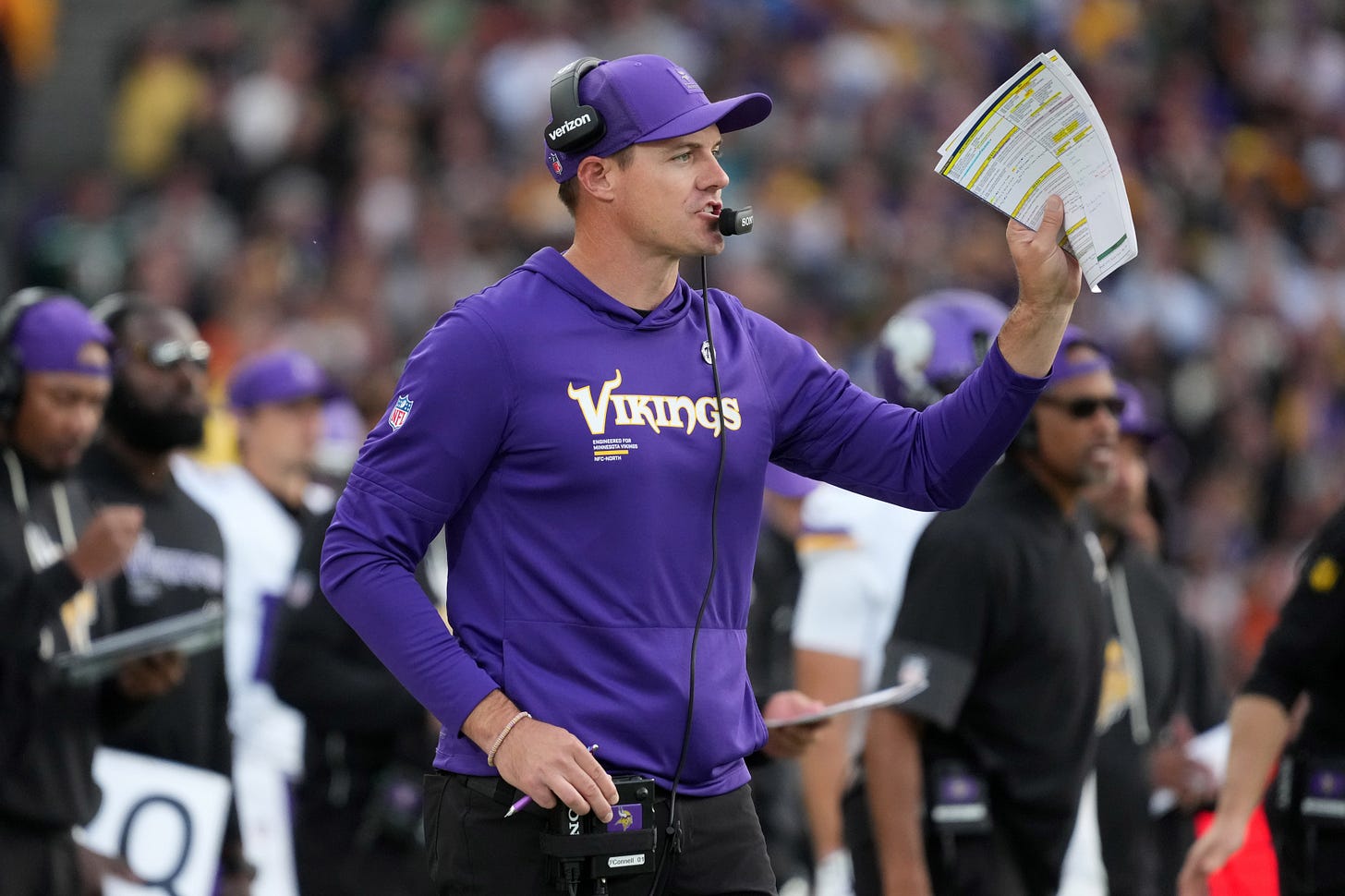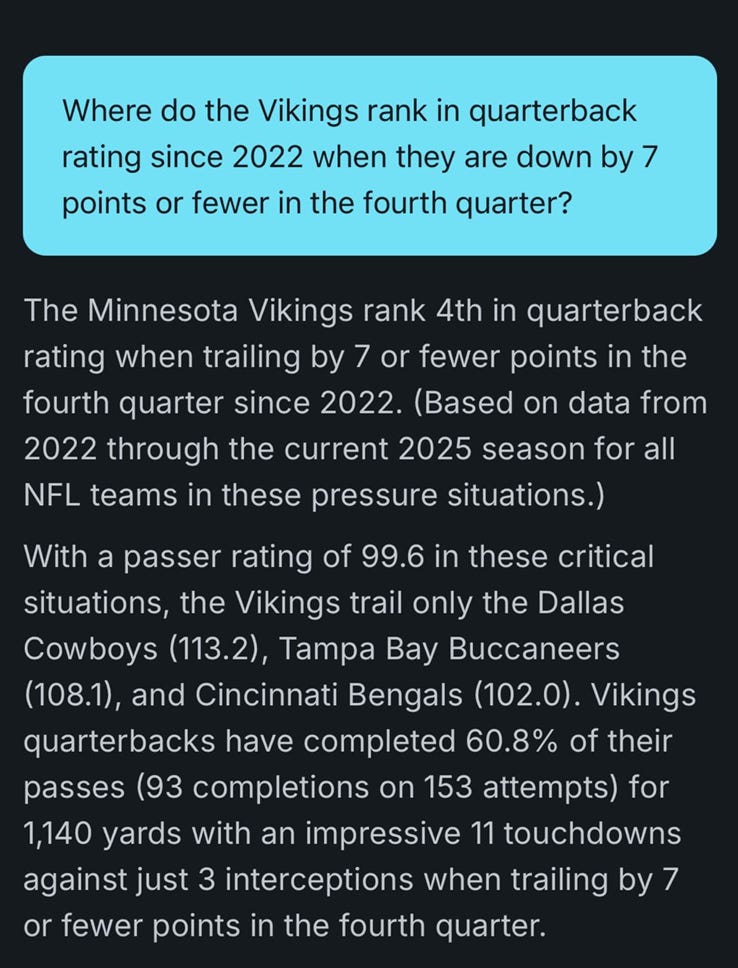Sample size is growing of Vikings clutch success
The Vikings have two more game-winning drives this season, including a key victory over Cleveland

By Matthew Coller
EAGAN — There is certainly a random element to winning tight games. We see fluctuations from year to year and any club can be heroic in one fourth quarter and then look foolish the next.
But just because something has some randomness doesn’t mean it is completely random.
If randomness was solely to blame, then every team would hover around .500 in one-score games eventually. Instead the Chicago Bears have won six times in 28 chances since 2022 and the Super Bowl-winning Philadelphia Eagles have gone 27 for 34 in one-score wins.
The Minnesota Vikings are one of the top teams in one-score game win percentage since Kevin O’Connell took over, going 28-10 in 38 such contests.
We know that all of those games were not created equal. Sunday’s victory over the Cleveland Browns was a narrow escape with the Vikings’ win probability dipping below 30% late in the game. There have been other wins — like both against Green Bay last year — in which the Vikings were ahead the entire game and narrowly held on at the end. For some reason those two types of one-score games are lumped together.
Anyway, in the push-comes-to-shove moments late in games, the Vikings have been overall very good. Out of those 28 one-score wins, 17 of them required game-winning drives between Kirk Cousins, Josh Dobbs, Nick Mullens, Sam Darnold, JJ McCarthy and Carson Wentz. To put that in context, the league leaders since 2022 in game-winning drives are Josh Allen and Patrick Mahomes, who have 13 and 12, respectively.
As a committee, the Vikings quarterbacks have performed at a particularly high level statistically with the game on the line late.
Per SumerSports, they have the fourth highest QB rating in the NFL in the fourth quarter when trailing by one score.
With the sample size growing of O’Connell’s QBs succeeding in the biggest moments, it’s worth asking: Is there something that the play caller is doing that is giving his QBs an edge when they need to score points?
For KOC, winning late in the fourth quarter starts with taking note throughout the game of the way that opponents are playing them defensively.
“A lot of times in the game, things are expressing themselves throughout and you’re kind of answering…either unscouted looks or unique ways Justin [Jefferson] is being defended their or pressure plan, whatever it might be, and then being able to take all that information and put it together,” O’Connell said.
During KOC’s tenure, he has emphasized situational football, which means hammering home a lot of details to his players that could matter when every second counts.
“[Being] on top of [our] rules of catching the ball inside the numbers and getting vertical or catching the ball outside the numbers and trying to get out of bounds,” O’Connell explained. “Little things, how we spot the ball, how we try to use our no huddle offense that we have different phases of it and layers to it to be able to apply in those moments.”
The X’s and O’s and coaching points were evident on Sunday, whether it was getting a one-on-one matchup for Jefferson to create a big gain down the sideline or the motions that deceived the Browns defense when they needed a couple yards to extend the drive or the clock management.
Usually we associate a coach’s handling of the clock simply by when he calls timeouts but in this case, O’Connell understanding the types of plays he could call when getting the ball back with just under three minutes left was key.
“Sometimes [it is] shorter completions just to ensure ourselves a new set of downs and then be able to reset,” O’Connell said. “I thought a couple guys made some pretty critical plays, run after catch or getting out of bounds that just kind of allowed us to move in chunks of yardage.”
The Vikings tend to check off a lot of the 100-level boxes of being a good clutch team. Where O’Connell takes it to the advanced level is his connection in the headset with the quarterback.
“It’s a weird type of communication, right? They can hear my voice, but hopefully they’re not looking over at me to see the way I’m delivering it,” O’Connell said. “What gets hard is when the play clock starts to creep towards that 15 number [when the headset turns off] and you’re trying to give the information that’s in my head to the quarterback so they could best execute the play.”
Basically O’Connell tries to deliver as much as he can into the headset with every extra second — and not freak out.
“I try to be as poised as possible in the moment,” KOC continued.
But the biggest thing might be that the head coach encourages his quarterback not to try to do more than what is needed for the play.
“The final piece of that is the trust of the quarterback,” O’Connell said. “Trust in each play as its own, not trying to think that there’s a need to overcome the play call and find the deep element in the play,” O’Connell explained.
That seems counter intuitive considering the heroic nature of the position, yet it makes sense through the lens of the win over Cleveland. Wentz made a smart checkdown to TJ Hockenson that got things going and then got rid of the ball quickly to Jefferson on a jump ball and then threw two key balls to Jordan Addison in the flat and executed a staple KOC concept to Addison for the win. He didn’t play John Elway out there.
SumerSports data scientist Sam Bruchhaus looked deeper into the specific types of play calls that O’Connell uses in the fourth quarters of games. He said that the Vikings haven’t just leaned on one concept.
“He mixes in all kinds of interesting plans and play designs and he does it all at an above average level, which means that [the defense] can’t just sit back and play prevent defense when it’s getting late in games,” Bruchhaus said. “While there is some variance, you can rest assured that O’Connell is going to unload the clip and has a plan for his quarterbacks in the fourth quarter.”
The bottom line is that it’s possible KOC’s record with QBs performing well in fourth quarters will regress and his one-score game record will fade, but that doesn’t mean that the Vikings’ tight wins were just the bounces of a funny-shaped ball. It’s a legitimate edge — and something tells me they’re going to need it a lot this year.


Two things can be true:
1. KOC does a good job late in games and gives his players the best chance to succeed.
2. Football is not actually chess, or even basketball. There are a lot of messy, interconnected things happening, it's an oblong ball, and so it's very easy for something that should work to nevertheless go awry. It's fair to say that playing poorly and having to come back is less impressive than being up and letting a team get closer, but in both cases a team is still in that "easy to go awry" zone.
Close games happen regularly, so it's better to be more successful in them than less successful. But, it would also be nice to have more two-score victories.
Definitely doesn’t feel like it’s all luck watching the games. Having an older, more experienced roster has probably helped more than a few times. Remember Patrick Peterson having one or two late game picks and his descriptions of those plays after the game sounded like he just knew what to expect from the QBs in that situation. Older players and a great coaching staff should lend itself to making smart adjustments as the game goes on, and that pretty much lines up with what we’ve seen from this team since KOC took over.